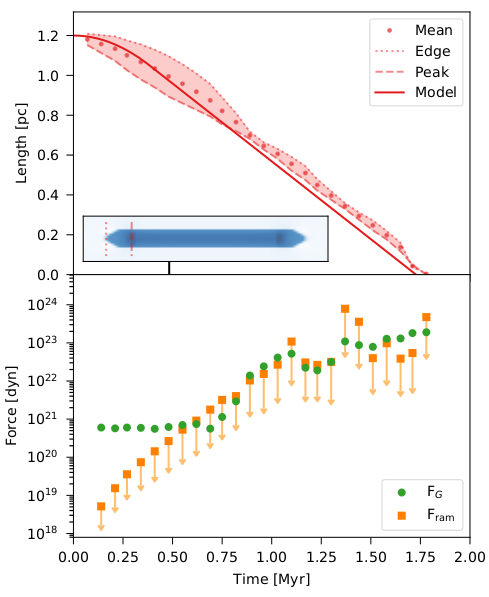| EPoS Contribution |
|
Filament collapse: A two phase process
Elena Hoemann MPE/USM, Munich, DE | |
| In self-gravitating filaments the gravitational acceleration has a steep increase towards the ends of the filament which leads to a pile-up of matter in the end regions during the overall filament collapse, called the edge effect. However, the edge effect remains a big puzzle since it is theoretically expected, but only rarely observed. We used a simple analytic approach to describe the dynamics of the collapse and the collapse time. The model consists out of two distinct phases: a free fall dominated phase which is followed by a phase of force equilibrium between the ram pressure of the swept-up gas and the self-gravity of the filament. Our analytic approach is in good agreement with hydrodynamic simulations and reproduces the established collapse timescale which was only determined empirically so far. The comparison of timescales suggests that the edge effect should dominate in low line-mass filaments as in large line-mass filaments fragmentation is supposed to happen simultaneously. Furthermore, we investigate how different radial density profiles affect the collapse and whether certain density gradients at the end of the filament can stop or reduce the edge effect. | |
 | |
| Caption: The graph depicts the simulated length and force evolution for a filaments. The upper panel shows the length evolution of the filament (simulation snapshot in the subplot). The length evolution in the simulation is given by the lighter colours whereas the solid read line shows the results of our two phase model. First the end accelerates and after a certain time reaches a final terminal velocity. The simulation and our modal agree very well. The force evolution of the filament is presented in the lower panel. Orange squares represent the force given by the ram pressure of the gas being swept-up and the green dots show the gravitational force the edge experiences due to self-gravity in comparison. The distinction between the two phases can easily be seen: First the gravitational attraction dominates, which is caught up by the ram pressure later on. | |
| Collaborators: A. Burkert, USM/MPE, DE S. Heigl, USM, DE K. Widmaier, USM, DE |
Key publication
Suggested Session: Filaments |

